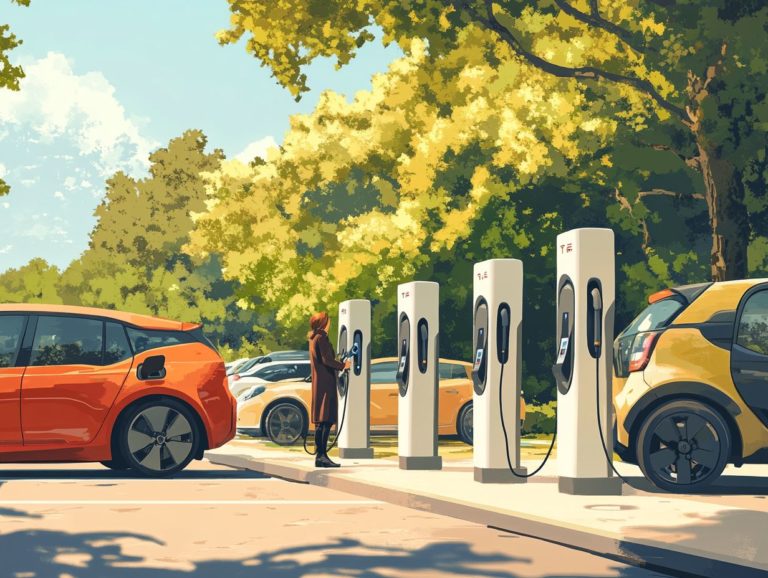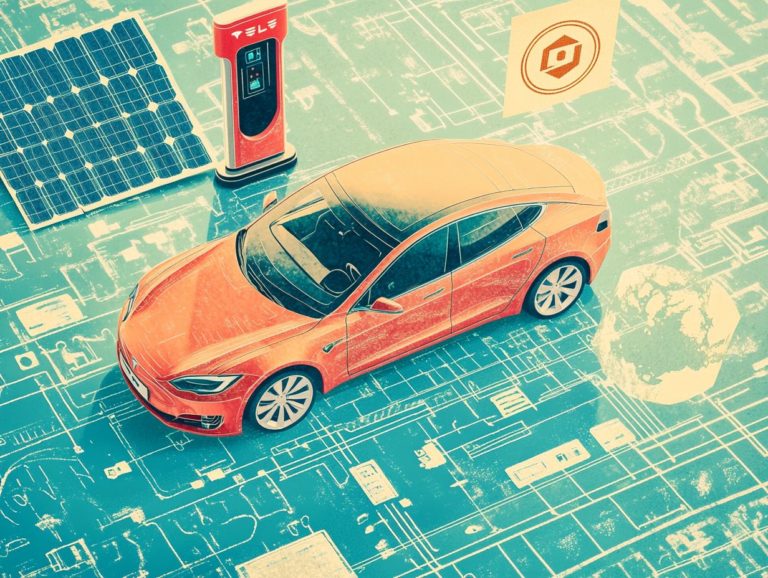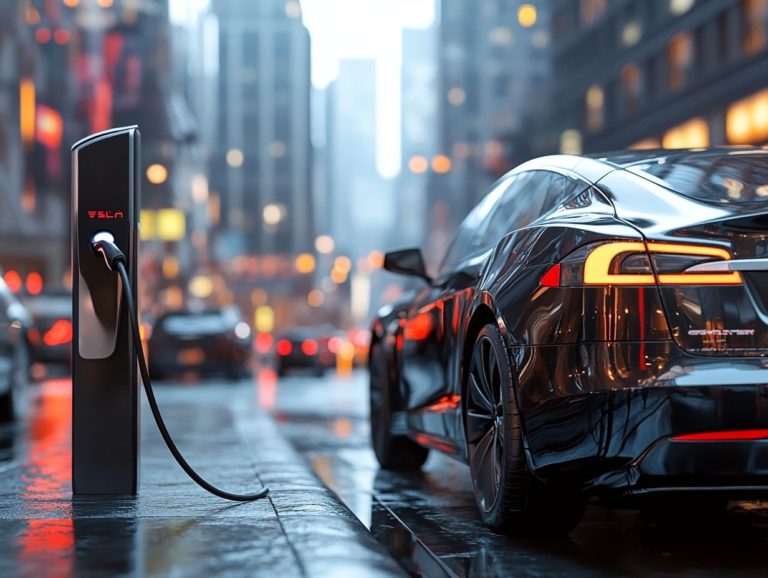5 Essential Safety Features in Electric Vehicles
Electric vehicles (EVs) are swiftly revolutionizing the automotive landscape, providing not only eco-friendliness but also heightened safety for both drivers and passengers.
This article delves into five key safety features that distinguish EVs from traditional vehicles, showcasing innovations like the Battery Management System and advanced Regenerative Braking. You ll discover how these features enhance crash safety ratings and improve fire safety measures while considering potential concerns and regulations in the ever-evolving EV industry.
Explore with us as we reveal what makes electric vehicles a superior and safer choice on the road today.
Contents
- Key Takeaways:
- 1. Battery Management System (BMS)
- 2. Regenerative Braking System
- 3. Crash Safety Ratings
- 4. Fire Safety Measures
- 5. Emergency Disconnect and Shut-Off Systems
- What Makes Electric Vehicles Safer Than Traditional Vehicles?
- Frequently Asked Questions
- What are the 5 essential safety features in electric vehicles?
- Why is a high-voltage battery deactivation system important in electric vehicles?
- How Does Electronic Stability Control Enhance Electric Vehicle Safety?
- What Makes Electric Vehicle Structures Strong?
- How Does the Airbag System Improve Safety?
- Why Is Tire Pressure Monitoring Important?
Key Takeaways:

- Electric vehicles have a Battery Management System to monitor and control the battery’s temperature, voltage, and state of charge, ensuring safe operation.
- The Regenerative Braking System in electric vehicles not only improves efficiency but also enhances safety by slowing down the vehicle and recharging the battery.
- Electric vehicles have high safety ratings due to their durable and rigid structures, advanced airbag systems, and other crash safety features.
1. Battery Management System (BMS)
The Battery Management System (BMS) is essential for ensuring the efficient operation and longevity of electric vehicles (EVs). It carefully manages charge cycles and monitors battery health, optimizing the performance of lithium-ion batteries under various driving conditions.
By integrating advanced algorithms and high-voltage systems, the BMS enhances your driving experience while bolstering the safety and reliability of electric propulsion technology.
This sophisticated system tracks key parameters like voltage, current, and temperature. It also communicates seamlessly with charging infrastructure. By accurately determining the state of charge and state of health, the BMS alleviates range anxiety, enabling you to plan your journeys with confidence.
Its real-time data maximizes energy efficiency, ensuring your battery operates within safe limits to prolong its lifespan.
The BMS plays a vital role in efficient thermal management, which means keeping the battery at a safe temperature, safeguarding against overheating and potential hazards. In the world of modern electric transportation, it establishes itself as an essential component for any discerning driver.
2. Regenerative Braking System
The Regenerative Braking System in electric vehicles enhances your acceleration performance and plays a crucial role in conserving energy. It converts kinetic energy back into stored electrical energy during braking, a game-changer for efficiency.
This cutting-edge technology allows you to extend your driving range by reusing energy that would typically be lost as heat with conventional braking. As your vehicle slows down, the electric motor seamlessly switches roles to generate electricity, storing it in the battery for later use.
Imagine navigating hilly terrains or dealing with stop-and-go traffic; this system truly shines in those scenarios. It continuously boosts energy efficiency while enhancing safety features.
By integrating regenerative braking with collision avoidance systems, your vehicle can decelerate more effectively in emergencies, potentially lessening the impact of accidents.
3. Crash Safety Ratings
Crash safety ratings are vital benchmarks that reflect the safety of electric vehicles. Organizations like the National Highway Traffic Safety Administration and the Insurance Institute for Highway Safety evaluate how these vehicles perform in collision scenarios.
These ratings carefully examine factors including structural integrity, crumple zones, and the efficacy of advanced safety systems such as automatic emergency braking and lane departure warnings. Electric vehicles often showcase innovative designs that enhance weight distribution, which helps maintain stability during accidents.
In contrast, traditional vehicles tend to rely on more conventional structures, which may not always provide the dynamic protection that some electric models offer. Ultimately, these safety ratings hold significant sway in consumer decision-making.
As buyers increasingly prioritize protective features, they seek assurance for themselves and their passengers on the road.
Consider electric vehicles for your next purchase and experience the safety and innovation they offer!
4. Fire Safety Measures

Fire safety measures are essential in the design and operation of electric vehicles. This is particularly important due to the unique risks posed by lithium-ion batteries and high-voltage systems. When considering an EV, it’s crucial to be aware of various factors, including the top 5 features to avoid in an EV. Rigorous testing and advanced safety features are necessary to reduce potential hazards.
Manufacturers are aware of these challenges and have established comprehensive protocols prioritizing thorough battery testing. They evaluate battery performance under extreme conditions.
Companies like Tesla and General Motors push boundaries by using innovative materials to improve battery casing, helping to prevent overheating issues.
Emergency response strategies are also a top priority. Clear guidelines for first responders ensure they are prepared to handle incidents involving electric vehicles.
With ongoing technological advancements, such as heat sensors and automatic fire suppression systems, the electric vehicle industry is continually enhancing its approach to fire prevention. To ensure your safety, it’s important to know how to maintain your EV’s safety features!
5. Emergency Disconnect and Shut-Off Systems
Emergency disconnect and shut-off systems are essential safety features in electric vehicles. They are designed to protect both occupants and first responders by quickly disabling high-voltage systems during an incident.
These systems provide a clear mechanism that can be activated immediately in an emergency, effectively reducing risks associated with electric shock or fire hazards. Their significance is profound, allowing for a quick response in time-sensitive situations.
Regulatory bodies have established comprehensive guidelines governing the installation and functionality of these systems. This underscores the need for reliability and user-friendliness. With advancements in technology, such as smart sensors and automated alerts, these systems have become more intuitive and responsive, ultimately enhancing safety on the road.
What Makes Electric Vehicles Safer Than Traditional Vehicles?
Electric vehicles are often viewed as the safer choice compared to traditional cars. They come equipped with advanced driver assistance systems (ADAS) and unique safety features that enhance overall vehicle safety. This includes 5 key innovations in electric vehicle technology, such as collision avoidance systems and superior structural designs that work to minimize injury risk in accidents.
The low center of gravity from electric propulsion significantly reduces the risk of rollovers, a common concern with gas-powered vehicles. This advantage enhances stability and provides greater control during sharp turns or emergency maneuvers.
As you consider your next vehicle purchase, safety is likely at the forefront of your mind. Many consumers prioritize vehicles with impressive safety ratings and cutting-edge technologies. Research continues to showcase the benefits of electric vehicles’ safety features, and how safety standards are evolving for EVs, boosting buyer confidence and encouraging a shift away from traditional combustion engine options.
How Do Electric Vehicle Safety Features Compare to Traditional Vehicle Safety Features?
Electric vehicle safety features surpass those of traditional vehicles, incorporating cutting-edge technology like advanced driver assistance systems that enhance collision avoidance and improve stability. When considering an EV, it’s also important to look for the 5 must-have features in an EV charger to ensure optimal performance.
These innovations include pedestrian detection systems capable of identifying potential hazards in real time, significantly reducing the risk of accidents, especially in urban environments. Autonomous emergency braking is another standout feature, enabling vehicles to intervene when a collision seems imminent something often less effective in older models.
In contrast to traditional vehicles that rely primarily on manual driver interventions and basic systems like anti-lock brakes, these electric advancements signify a monumental shift in safety approaches. By integrating smart technology, electric vehicles not only prioritize the safety of their occupants but also enhance the driving experience with must-have accessories for your electric car, protecting pedestrians and other road users, and fostering a safer driving environment for everyone.
What Are the Potential Safety Concerns with Electric Vehicles?

Despite the impressive advancements in electric vehicles, potential safety concerns linger, particularly with battery technology. Issues like thermal runaway, a situation where a battery overheats and can catch fire, and fire hazards highlight the need for robust emergency response protocols.
As your interest in electric vehicles grows, so does the focus on battery management systems aimed at mitigating these risks. Manufacturers are stepping up by implementing sophisticated thermal management technologies and advanced battery monitoring systems that track battery health and performance in real-time.
This proactive strategy not only helps prevent dangerous situations but also offers you peace of mind, knowing that automotive companies are dedicated to your safety. Training programs for first responders are being developed to equip them with the knowledge necessary to effectively handle electric vehicle incidents, reinforcing safety protocols and ensuring readiness in emergency situations.
What Are the Regulations and Standards for Electric Vehicle Safety?
Regulations and standards for electric vehicle safety are established by authoritative bodies like the National Highway Traffic Safety Administration and the Insurance Institute for Highway Safety. These organizations ensure that all vehicles adhere to rigorous safety benchmarks.
The guidelines you encounter encompass not only crash-test performance and battery safety but also the overall design and manufacturing protocols that automakers must follow. By implementing comprehensive standards, the industry aims to mitigate risks associated with electric vehicle operation, reinforcing safety measures from the initial design phase through production.
For you as a consumer, adherence to these standards instills confidence in the reliability and safety of your vehicle. Meanwhile, manufacturers enjoy streamlined processes that enhance their reputation and market competitiveness. Ultimately, these regulations are key to shaping a trustworthy landscape for electric vehicles.
How Can Electric Vehicle Manufacturers Continue to Improve Safety Features?
Electric vehicle manufacturers can consistently elevate safety features by investing in advanced safety systems, incorporating your feedback, and remaining vigilant about technological advancements. Keeping an eye on innovations in EVs ensures a secure and comfortable driving experience for you.
To enhance safety even further, these manufacturers might consider forming partnerships with established safety organizations that specialize in vehicle assessment and accident prevention. Regular vehicle testing plays a crucial role in identifying areas for improvement, minimizing risks associated with emerging technologies.
The integration of smart navigation systems can significantly enhance your situational awareness, helping you steer clear of hazardous conditions. By adopting these practical strategies, manufacturers not only raise safety standards but also bolster your confidence as a consumer. This, in turn, fuels market growth and positions them as leaders in the ever-evolving automotive landscape.
Frequently Asked Questions
What are the 5 essential safety features in electric vehicles?

Here are five essential safety features in electric vehicles:
- A system to deactivate the high-voltage battery.
- Electronic stability control.
- Strong and crash-resistant structure.
- Advanced airbag system.
- Tire pressure monitoring system.
Why is a high-voltage battery deactivation system important in electric vehicles?
A high-voltage battery deactivation system is important in electric vehicles because it allows for safe handling and maintenance of the high-voltage battery. In case of an accident or emergency, the system can quickly disconnect power to the battery, reducing the risk of electric shock or fire.
Explore the latest in electric vehicle safety features and drive with confidence!
How Does Electronic Stability Control Enhance Electric Vehicle Safety?
Electronic stability control is vital for safety in electric vehicles. It helps maintain control in dangerous situations by using sensors to detect skidding and loss of traction.
What Makes Electric Vehicle Structures Strong?
Electric vehicle structures are built to be strong and crash-resistant. With reinforced frames and special zones that absorb impact, they protect passengers during collisions.
How Does the Airbag System Improve Safety?
The airbag system in electric vehicles includes multiple airbags in key areas. They deploy with less force to reduce injury risks for drivers and passengers.
Why Is Tire Pressure Monitoring Important?
A tire pressure monitoring system alerts drivers if tire pressure drops significantly. Keeping tires properly inflated prevents accidents caused by loss of control.






